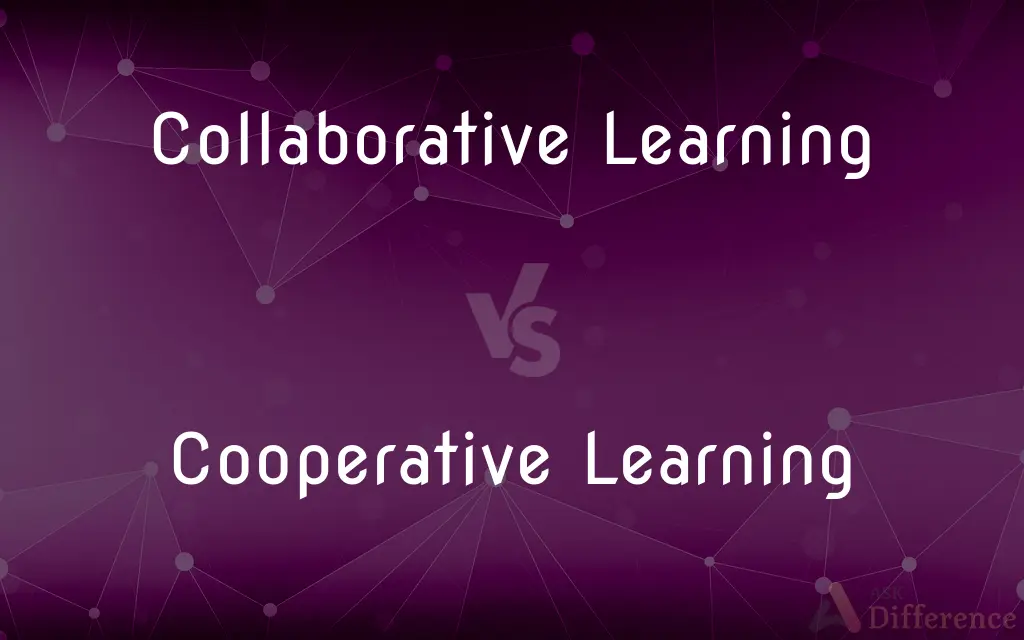Collaborative Learning vs. Cooperative Learning — What's the Difference?
By Tayyaba Rehman — Published on December 14, 2023
Collaborative Learning is when learners work together to create knowledge, while Cooperative Learning involves structured group activities with assigned roles. Both foster group interaction but differ in approach and structure.

Difference Between Collaborative Learning and Cooperative Learning
Table of Contents
ADVERTISEMENT
Key Differences
Collaborative Learning is an approach where learners actively engage with one another to construct understanding and discover new knowledge. The process is open-ended, and there may not be a fixed end goal in mind. The emphasis is on the collective knowledge-building process where ideas are freely exchanged, and learners rely on each other's expertise and perspectives. Cooperative Learning, on the other hand, is typically more structured.
Cooperative Learning often involves tasks or activities where group members have specific roles or responsibilities. These roles are assigned to ensure that each participant contributes to the group's success. The goals are usually predetermined, and the process is more guided than in Collaborative Learning. Cooperative Learning emphasizes individual accountability within a group framework.
In Collaborative Learning, the emphasis is on the shared creation of knowledge. There is a mutual interdependence as learners navigate problems and construct solutions together. It's more about the journey of understanding and the shared insights gained along the way. Cooperative Learning, however, emphasizes the outcome, with each member playing a crucial part to achieve the shared objective.
Collaborative Learning thrives on open dialogue and the organic flow of ideas. The learners drive the process, often deciding the direction of their inquiry. In contrast, Cooperative Learning is more about achieving a specific goal through coordinated effort, where each learner's contribution is vital for the group's overall success.
Comparison Chart
Structure
Open-ended, fluid
Structured, with specific roles
ADVERTISEMENT
Focus
Process of mutual knowledge building
Achieving a specific goal
Interdependence
High; learners rely on shared insights
Role-based; each has a specific contribution
Guidance
Learner-driven, less guidance
More guided, often with clear instructions
Accountability
Collective accountability for shared understanding
Individual accountability within a group framework
Compare with Definitions
Collaborative Learning
Collaborative Learning thrives on open dialogue and shared inquiry.
The history class embraced Collaborative Learning, often having open debates to dissect historical events.
Cooperative Learning
Cooperative Learning involves structured group activities with distinct roles for each member.
In their science project, students practiced Cooperative Learning by assigning research and presentation parts to each member.
Collaborative Learning
Collaborative Learning is a process where participants engage in joint problem-solving.
In the physics lab, students used Collaborative Learning to understand complex concepts by discussing their observations.
Cooperative Learning
It focuses on individual accountability while working towards a group objective.
Through Cooperative Learning, the debate team prepared for their competition, with each member mastering a specific argument.
Collaborative Learning
Collaborative Learning emphasizes the mutual creation of knowledge and understanding.
Through Collaborative Learning, the literature students co-wrote a critical analysis of a novel, blending their perspectives.
Cooperative Learning
Cooperative Learning is about achieving a shared goal through coordinated group efforts.
The marketing team used Cooperative Learning strategies to launch a campaign, with each member responsible for a specific task.
Collaborative Learning
It's an educational approach that values the collective over the individual.
By using Collaborative Learning in the workshop, participants combined their skills to design a prototype.
Cooperative Learning
It's an educational approach emphasizing individual contribution within a collective framework.
The math class adopted Cooperative Learning, ensuring everyone played a part in solving the complex equation.
Collaborative Learning
It's when learners co-construct knowledge, relying on each other's expertise.
The tech team used Collaborative Learning to troubleshoot a software problem, leaning on each other's areas of expertise.
Cooperative Learning
Cooperative Learning tasks often come with predetermined goals and clear instructions.
The teacher utilized Cooperative Learning for the book review assignment, with each student analyzing a different chapter.
Common Curiosities
Which method is more learner-driven: Collaborative or Cooperative Learning?
Collaborative Learning is typically more learner-driven than Cooperative Learning.
Can Collaborative Learning be unstructured?
Yes, Collaborative Learning can be open-ended and unstructured, emphasizing the process of shared discovery.
What is the main goal of Collaborative Learning?
The main goal of Collaborative Learning is the mutual creation of knowledge through joint problem-solving.
Is there individual accountability in Cooperative Learning?
Yes, in Cooperative Learning, each member is accountable for their specific role within the group framework.
Does Collaborative Learning emphasize the outcome?
Collaborative Learning is more about the shared process of discovery than the specific outcome.
Does Cooperative Learning always have set roles for students?
Often, but not always. While structured roles are common in Cooperative Learning, variations might not assign fixed roles.
How does Cooperative Learning ensure every student participates?
Cooperative Learning assigns specific roles or tasks to each group member, ensuring individual contribution.
Is group size crucial for Cooperative Learning?
Yes, group size matters in Cooperative Learning to ensure that each member can contribute effectively.
Can Collaborative Learning occur in virtual settings?
Absolutely. Collaborative Learning can happen in any setting where participants can interact and share insights, including online platforms.
Can both Collaborative and Cooperative Learning be used in the same class?
Yes, depending on the learning objectives, both methods can be integrated into a single course or lesson.
Which is more flexible, Collaborative or Cooperative Learning?
Collaborative Learning is generally more flexible and open-ended than Cooperative Learning.
Can Collaborative Learning be practiced individually?
No, Collaborative Learning inherently involves interaction among learners to co-construct knowledge.
What's a primary challenge of Collaborative Learning?
Ensuring equal participation can be challenging in Collaborative Learning since it's less structured than Cooperative Learning.
In what scenarios is Cooperative Learning most effective?
Cooperative Learning is effective when tasks require structured group work and individual accountability.
How is feedback typically provided in Cooperative Learning?
Feedback in Cooperative Learning can be provided by both peers and instructors, focusing on individual roles and group outcomes.
Share Your Discovery

Previous Comparison
MLA vs. MP
Next Comparison
VB vs. CAuthor Spotlight
Written by
Tayyaba RehmanTayyaba Rehman is a distinguished writer, currently serving as a primary contributor to askdifference.com. As a researcher in semantics and etymology, Tayyaba's passion for the complexity of languages and their distinctions has found a perfect home on the platform. Tayyaba delves into the intricacies of language, distinguishing between commonly confused words and phrases, thereby providing clarity for readers worldwide.














































